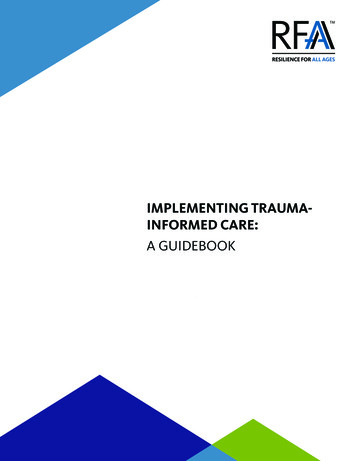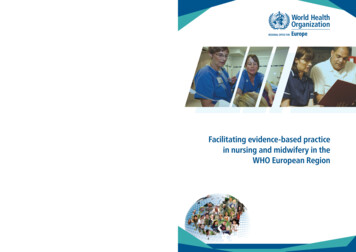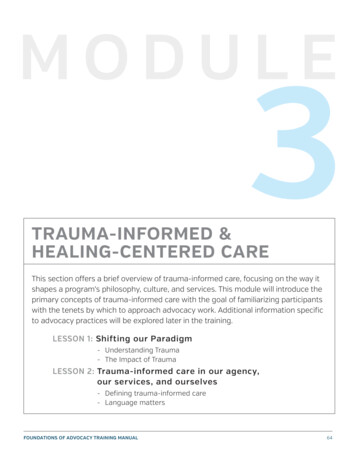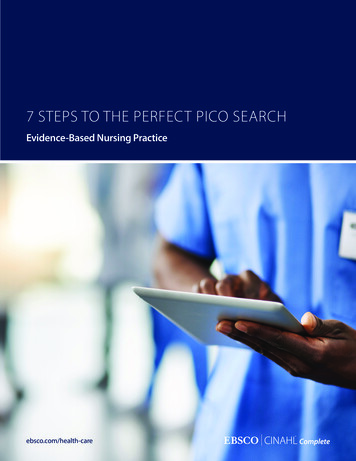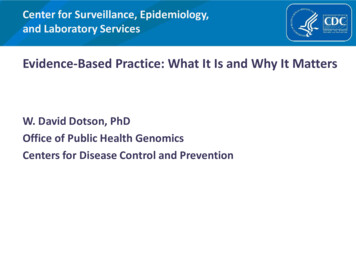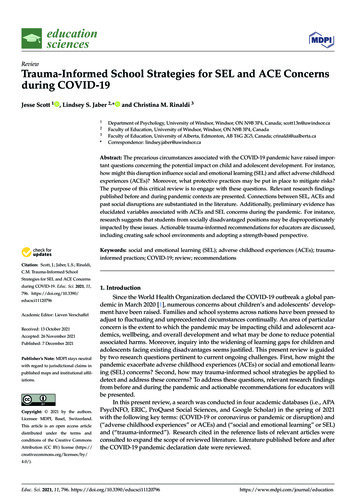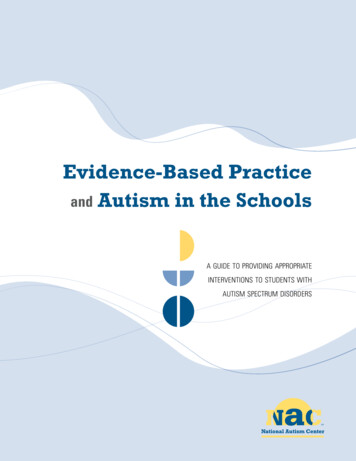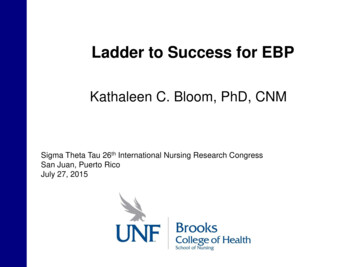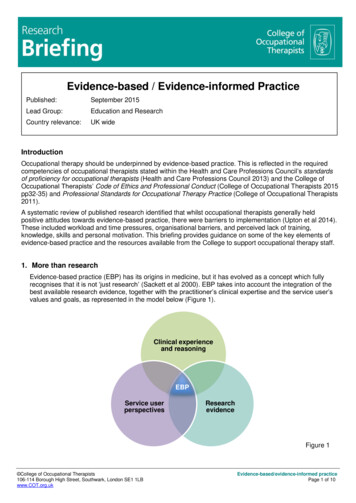
Transcription
Evidence-based / Evidence-informed PracticePublished:September 2015Lead Group:Education and ResearchCountry relevance:UK wideIntroductionOccupational therapy should be underpinned by evidence-based practice. This is reflected in the requiredcompetencies of occupational therapists stated within the Health and Care Professions Council’s standardsof proficiency for occupational therapists (Health and Care Professions Council 2013) and the College ofOccupational Therapists’ Code of Ethics and Professional Conduct (College of Occupational Therapists 2015pp32-35) and Professional Standards for Occupational Therapy Practice (College of Occupational Therapists2011).A systematic review of published research identified that whilst occupational therapists generally heldpositive attitudes towards evidence-based practice, there were barriers to implementation (Upton et al 2014).These included workload and time pressures, organisational barriers, and perceived lack of training,knowledge, skills and personal motivation. This briefing provides guidance on some of the key elements ofevidence-based practice and the resources available from the College to support occupational therapy staff.1. More than researchEvidence-based practice (EBP) has its origins in medicine, but it has evolved as a concept which fullyrecognises that it is not ‘just research’ (Sackett et al 2000). EBP takes into account the integration of thebest available research evidence, together with the practitioner’s clinical expertise and the service user’svalues and goals, as represented in the model below (Figure 1).Clinical experienceand reasoningEBPService userperspectivesResearchevidenceFigure 1 College of Occupational Therapists106-114 Borough High Street, Southwark, London SE1 1LBwww.COT.org.ukEvidence-based/evidence-informed practicePage 1 of 10
Links between evidenced-based, evidence-informed and values-based practiceThe term evidence-informed practice is now increasingly being used within health and social care. Whilstvarious models of evidence-informed practice exist, they tend to conceptualise clinical expertise as beinginformed by the best available research, as well as contextual factors such as: service user preferencesand actions; clinical state and circumstances; and, sometimes, healthcare resources. Such modelstherefore share common theoretical features with models of evidence-based practice, particularly in termsof the integration of best evidence with the service user context. However, it has been suggested thatevidence-informed practice is perhaps a more appropriate term for such processes of integrating evidenceand contextual factors, particularly as the amount of valid evidence available can vary and its use can beinexact (Shlonsky and Mildon 2014).Values-based practice is an approach to working with complex and conflicting values in healthcare(Fulford 2008, Warwick Medical School 2013) that supports balanced decision making between cliniciansand service users (Peile and Fulford 2015). It has been identified that this approach is complimentary to,and can be used in partnership with, evidence-based practice to inform clinical decision making and topromote care that is both science-based and person-centred (Fulford 2008, Peile and Fulford 2015).For clarity, and in recognition of the terminology used within much of the reference material, this briefingwill predominantly use the term evidence-based practice.2. Making sense of the evidenceIf a therapist uses their clinical experience and well-thought through reasoning (enhanced by the routineuse of standardised assessments and outcome measures) and affords due consideration to theindividual perspectives of service users, they would be addressing two of the key components ofevidence-based practice outlined in Figure 1. It is research evidence, and its application, which is oftenviewed as the stumbling point. This section will therefore focus on this aspect of evidence-basedpractice.The Health and Care Professions Council (HCPC) requires that occupational therapists should ‘be awareof the principles and applications of scientific enquiry, including the evaluation of treatment efficacy andthe research process’ (Health and Care Professions Council 2013 p13) whilst COT’s Code of Ethics andProfessional Conduct requires that you are able ‘to access and understand and critically evaluateresearch and its outcomes, incorporating it into your practice where appropriate’ (College of OccupationalTherapists 2015 p37). It is therefore important to consider how you can meet these standards.Firstly, it is useful to remind yourself that evidence-based practice is not in itself a single entity or,necessarily, a linear one. Bannigan (2007) identified five stages: Formulating a clear, clinical question.Finding the best evidence in the literature to answer the question.Critically appraising that evidence for its clinical usefulness and validity.Implementing useful findings in practice.Evaluating the effectiveness of the new way of working. College of Occupational Therapists106-114 Borough High Street, Southwark, London SE1 1LBwww.COT.org.ukEvidence-based/evidence-informed practicePage 2 of 10
These stages can usefully be seen within a cyclical process:Formulateyour practicequestionEvaluate ifeffectiveImplementusefulfindingsFind the bestevidenceCriticallyappraise theevidenceLike all things that appear complex, breaking down ‘evidence-based practice’ into smaller bite-sizedpieces makes it feel more manageable.A. Formulate your practice questionBe clear about the topic for which you require evidence, its purpose and why it is important. Thinking of itin terms of a practice question can help to make the identification of the appropriate evidence lesscomplicated.Using the PICO methodology (Richardson et al 1995) can assist in drilling down the specific area ofpractice you really need to examine: The Patient (service user), Population or Problem/circumstance.The Intervention under investigation or action.The Comparison, which is an alternative intervention or action.The desired Outcome.This approach can be helpful and provide you with the basic terms you will need in your search forevidence.B. Find the best evidenceThe main sources of research evidence are best found via a thorough literature search.Identify the search terms: search terms can include the service user group or problem (e.g. older adults,stroke); the intervention (e.g. constraint induced movement therapy); and the outcomes (e.g. occupationalengagement). In order to find the widest range of literature on the topic, alternative terms should besuggested for each of these concepts (e.g. older people, older persons, elderly). It is also important to College of Occupational Therapists106-114 Borough High Street, Southwark, London SE1 1LBwww.COT.org.ukEvidence-based/evidence-informed practicePage 3 of 10
consider whether there may be variations in spelling, such as between English and American words (e.g.paediatric/pediatric). Most librarians will be able to offer help with identifying and combining search terms.Search the databases: your search terms are used to interrogate one or more databases. Somedatabases are free to the internet user, such as PUBMED, OTseeker and the Cochrane database.Others, which can only be accessed by subscribers, include Allied and Complementary Medicine (AMED),Cumulative Index to Nursing and Allied Health Literature (CINAHL), PSYCINFO and Social Policy andPractice. OTDBASE is a specialist subscription database of abstracts from occupational therapy journals.An NHS or university librarian will advise on what databases are available to you. To carry out anexhaustive search, it is necessary to cover as many relevant databases as possible.Select papers and obtain the literature: a database search may bring up thousands of references so itis important to have clear inclusion/exclusion criteria for selecting papers to review. Importantconsiderations when setting such criteria can include: the relevance of the paper to the question, the typeof research, and the quality of the research. For example, the decision may be taken to only includereports of randomised controlled trials (RCT) or systematic reviews that include at least one RCT, or toexclude studies that occurred before a certain year.Some databases give online access to full text journal articles while others provide only an abstract.Selected papers can be obtained from a specialist library or via interlibrary loans. A librarian can advise.Information can also be found in grey literature and professional magazines (such as OTnews). Whilstthese can provide valuable perspectives and examples of practice, they are not usually research-basedand have not been peer reviewed. They cannot, therefore, be assumed to offer robust evidence andyou would need to be very cautious about the context in which you use any information from thesepublications. Similar care would need to be employed when considering whether to use generalinformation obtained from websites (as opposed to peer reviewed ejournals available on a website).C. Critically appraise the evidenceOnce you have tracked down relevant articles, you will need to appraise the evidence. Published researchin professional journals will, in the main, have been peer reviewed, but you still need to critically review thestrengths and limitations of the evidence and consider whether the findings can be generalised to yourarea of practice. Critical appraisal can provide an excellent continuing professional development activityeither alone, or with colleagues in a journal club.Frameworks for critically appraising different types of research are available. For example, the followingwebsites provide guidance information and templates/tools to help structure your appraisal: The Critical Appraisals Skills Programme (CASP)http://www.casp-uk.net/ McMaster University’s Occupational Therapy Evidence-Based Practice Research d-practice-research-group Centre for Evidence-based Medicinehttp://www.cebm.net/index.aspx?o 1157When considering different types of evidence, practitioners need to be aware that research designs vary interms of their robustness and the risk of error and bias in their results. Various hierarchies of evidence areavailable and these traditionally reflect the highest levels of evidence as systematic reviews andrandomised controlled trials. In terms of the nature of occupational therapy research and evidence,sources of information and evidence accessed will often need to be as inclusive as possible.The final stages of appraising the evidence involve asking if the findings answer the clinical question andusing clinical judgement to decide if they are likely to be clinically important. College of Occupational Therapists106-114 Borough High Street, Southwark, London SE1 1LBwww.COT.org.ukEvidence-based/evidence-informed practicePage 4 of 10
D. Implement useful findingsA review of the evidence may lead to identification of findings that support your current practice.Alternatively, it could lead you to consider whether you need to make changes to your practice. Adecision to make any changes should ideally be based on a body of evidence, and not made in isolationfrom your own expertise and experience, the individual service user’s needs and the environment in whichyou practice. Risks and benefits need to be considered, and any decision should be made in consultationwith/with the support of managers, service users, multidisciplinary team members and commissioners, asappropriate.E. Evaluate if effectiveIf you find evidence that is both robust and meaningful, and you have determined the potential benefitsand risks of implementing change to your area of practice, then don’t forget to evaluate the impact of thatchange to close the loop. Very much like the occupational therapy process, this may need to lead to ‘reassessment’ of the situation and so the cycle begins again.3. COT Evidence-based practice resourcesCOT has a number of resources to support evidence-based practice, available to members of the BritishAssociation of Occupational Therapists (BAOT).LibraryPracticeGuidelinesInformationSkills GuidesLibraryLiteratrureSearch &SearchoutputsSPEaRTopicsCOTresourcesOT EvidenceFactsheetshOT TopicsAssessment& OutcomeMeasuresinfoUKOTRFsummariesJournals &ejournals College of Occupational Therapists106-114 Borough High Street, Southwark, London SE1 1LBwww.COT.org.ukEvidence-based/evidence-informed practicePage 5 of 10
COT LibraryWhen it comes to searching for the evidence, there is a lot of useful information on the Library andPublications pages of the BAOT/COT website: http://www.cot.co.uk/cot-library/cot-library .The COT library houses a unique specialist collection of materials and resources to support the work andstudy of BAOT members, including reference books/ebooks, journals/ejournals and donated PhD thesesas well as offering access to a range of databases (further information on databases and theses isprovided in Section 4 of this document).The COT library team can support members in tracking down what information is available on a particulartopic, and obtain copies of articles through their document supply service.Information Skills guides: the library team have produced a number of information skills guides,including guides to literature searching and using particular databases. These can be accessed kills.Literature Searches and Literature Search outputs: the library team can carry out literature searchesfor BAOT members: e-search (please note, this service isnot available to those who are undertaking award-bearing courses who should refer to their universitylibrary). The results of some previous literature searches carried out by COT library staff are available onthe literature search outputs page: h-outputs.hOT Topics: an extensive collection of hOT Topics are available. These provide a useful starting pointand overview of key readings related to a particular subject, including articles, books and selectedwebsites. They cover a variety of subjects, ranging from areas of practice (e.g. vocational rehabilitation;palliative care), specific conditions (e.g. autism spectrum disorder) and other topics of interest (e.g. riskmanagement): ents and Outcome Measures library pages: the Assessment and Outcomes Measures webpages are another useful library resource for supporting evidence-based practice. They provideinformation about selecting and using assessments/outcomes measures and will signpost you to somekey resources. Access them at: outcome-measures.Journals and ejournals: in addition to the journals held in the COT library, a wealth of electronic journalsare available to BAOT members via the Library and Publications tab of the BAOT/COT website. Thismember benefit widens your exposure to international research and evidence. Ejournals available include: British Journal of Occupational Therapy (BJOT), the official journal of the College of OccupationalTherapists.American Journal of Occupational Therapy.Australian Occupational Therapy Journal.Canadian Journal of Occupational Therapy.An extensive range of other health and social care journals, including occupational therapy specifictitles.All ejournals can be accessed at: journals. This webpage also contains information about signing up for Table of Contents (TOC) alerts (or you can sign up toTOC alerts via individual journal websites). TOC email alerts enable you to keep up to date with newjournal articles being published as soon as they become available online. When you receive a TOC alert auseful starting point can be to review the abstracts and key messages to see if an article may providedetails of evidence which is relevant to your area of practice. College of Occupational Therapists106-114 Borough High Street, Southwark, London SE1 1LBwww.COT.org.ukEvidence-based/evidence-informed practicePage 6 of 10
UKOTRF Projects: Summaries of Key FindingsThe United Kingdom Occupational Therapy Research Foundation (UKOTRF) is a division of the Collegeof Occupational Therapists. UKOTRF supports research that will build the evidence-base for occupationaltherapy and increase research capacity within the profession. It has a role in raising awareness of thevaluable contribution of occupation to people's health and wellbeing.A summary of the key findings for each completed UKOTRF funded project (including, where known,journal publication references) can be accessed at: trf/funded-project-outputs-0All funded projects are required to provide a final project report, a hard copy of which will be placed in theCOT library for reference by members six months after the project has been signed off by COT.Occupational Therapy Evidence Fact SheetsOccupational therapy evidence factsheets provide concise information about a particular topic (e.g.developmental coordination disorder, falls management, hand therapy, reablement). The target audienceis commissioners. The factsheets provide key facts, examples of key benefits/cost benefits and relatedreference points: -fact-sheets.Practice guidelinesCOT has published a number of practice guidelines in conjunction with COT specialist sections. Practiceguidelines outline the nature and level of intervention that is considered best practice for specificconditions in specific populations. COT received NICE Accreditation in January 2013 (valid for five years)for the process it uses to produce its practice guidelines.The use of a robust process, which draws on available evidence to develop recommendations for practice,ensures that the practice guidelines are a good hallmark to demonstrate and implement evidence-basedpractice.Practice guidelines available include the following: Hand and wrist orthoses for adults with rheumatological conditions (2015).Occupational therapy in the prevention and management of falls in adults (2015).Splinting for the prevention and correction of contractures in adults with neurological dysfunction(2015).Occupational therapists’ use of occupation focused practice in secure hospitals (2012).Occupational therapy for adults undergoing total hip replacement (2012).All guidelines published since 2011 are supported by a quick reference guide, audit tool and continuingprofessional development session.If there is a guideline relevant to your service, then it is recommended that you carry out an audit againstthe recommendations and identify any action you might need to take.Access the guidelines at: ice-guidelines.SPEaR Topics (Supporting Practice: Evidence and Resources)There are numerous SPEaR topics available on the COT website. The SPEaR topics are an onlinesignposting resource and include topics related to particular conditions (e.g. dementia), areas of practice(e.g. housing) and topics relevant to occupational therapy practice (e.g. age friendly environments, publichealth). There are also SPEaR topics on Outcomes and on Research and evidence-informed practice. College of Occupational Therapists106-114 Borough High Street, Southwark, London SE1 1LBwww.COT.org.ukEvidence-based/evidence-informed practicePage 7 of 10
SPEaR topics direct members towards some key information on a particular topic by providing links torelevant web sites or documents. Links are usually to information that is freely accessible and in thepublic domain, or to professional journals accessible via the COT ejournal collection.All topics can be accessed via: -and-resources.4. Sources of evidenceThere are many sources of evidence available. The information below provides examples of some ofthose commonly used, although it is by no means intended to be a definitive list.BMJ Clinical EvidenceA database of high-quality, rigorously developed systematic overviews assessing the benefits and harmsof treatments, and a suite of evidence-based medicine (EBM) resources and training materials:http://clinicalevidence.bmj.comCochrane LibraryThe Cochrane Libary includes the following databases: Cochrane Database of Systematic Reviews (CDSR).Database of Abstracts of Reviews of Effects (DARE).Cochrane Central Register of Controlled Trials (CENTRAL).Health Technology Assessment Database (HTA).NHS Economic Evaluation Database (EED).Cochrane Methodology Register (CMR).Available at: http://www.thecochranelibrary.comCOT Library and Information ServiceThe COT Library provides access for members to the principal allied health databases. These include thefollowing databases for which COT holds a subscription: AMED (Allied and Complementary Medicine).CINAHL (Cumulative Index to Nursing and Allied Health Literature).HMIC (Health Management Information Consortium).MEDLINE (the U.S. National Library of Medicine's digital archive of life sciences journal literature.).PSYCINFO (psychology and related disciplines).Social Policy and Practice (social policy, public health, social services, and mental and communityhealth).OTDBASE – (international occupational therapy journal literature).OTSearch (the catalogue and database of the American Occupational Therapy Association).Members would need to visit the library to access these databases. However, COT librarians would beable to use the subscription databases, in addition to databases that are publically available on theinternet such as the Cochrane Library and OTSeeker, to carry out literature searches for members. Pleaserefer to section 3 of this document for more information regarding literature searches.In addition to providing access to principal databases, the COT library houses an extensive collection ofover 7000 reference books, holds print copies of over 50 key occupational therapy / occupational therapyrelevant journals and has a collection of over 650 unpublished UK Master’s and doctoral theses andreports. Find out more: http://www.cot.co.uk/cot-library/cot-library. College of Occupational Therapists106-114 Borough High Street, Southwark, London SE1 1LBwww.COT.org.ukEvidence-based/evidence-informed practicePage 8 of 10
Europe PubMed CentralA free online digital archive of full-text, peer reviewed research publications, based on PubMed Central:http://europepmc.org.Evidence-Based Occupational Therapy web portalThe Evidence-Based Occupational Therapy web portal is funded by the Canadian Occupational TherapyAssociation and McMaster University and is endorsed by the World Federation of OccupationalTherapists. It provides strategies, knowledge and resources to aid occupational therapists in finding outabout and using evidence: http://www.otevidence.info.National Elf ServiceThe National Elf Service is a collection of evidence-based websites, owned and managed by MinervationLtd, which aim to help busy health and social care professionals keep up to date with the latest research.It is intended that the sites will present high quality research, critically appraise it, and ask subject expertsto summarise it in simple and clear blogs. There are numerous ‘elf’ sites, including the: Commissioning ElfLearning Disabilities Elf, Mental Elf, and Musculoskeletal Elf.Find out more and access the separate Elf websites at: http://www.nationalelfservice.net/.NICE Evidence SearchNICE Evidence Search provides free access to a health and social care information web portal that allowsusers to search multiple sources simultaneously and gives access to specialist collections covering a widerange of conditions, topics and health populations. This includes the Quality, Innovation, Productivity andPrevention (QIPP) resource: https://www.evidence.nhs.uk.OTseekerOTseeker is a database of abstracts of systematic reviews and randomised controlled trials relevant tooccupational therapy. The validity and interpretability of the trials has, in most cases, been criticallyappraised: http://www.otseeker.com.Occupational Therapy Critically Appraised Topics (CATS)CATS gives access to short summaries of evidence on particular topics or clinical questions:http://www.otcats.com.Social Care OnlineA product of the Social Care Institute for Excellence, this website is a free database of social careinformation and research. It includes listings of research briefings, reports, government documents, journalarticles, events and websites. Available at: http://www.scie-socialcareonline.org.uk.Trip DatabaseThe Trip Database is a gateway to evidence-based healthcare resources, updated monthly:http://www.tripdatabase.com. College of Occupational Therapists106-114 Borough High Street, Southwark, London SE1 1LBwww.COT.org.ukEvidence-based/evidence-informed practicePage 9 of 10
ReferencesBannigan K (2007) Making sense of research utilisation. In: J Creek, A Lawson-Porter, eds. Contemporary issuesin occupational therapy: reasoning and reflection. John Wiley: Chichester. 189-216.College of Occupational Therapists (2015) Code of ethics and professional conduct. London: COT. Available cations/public/CODE-OF-ETHICS-2015.pdfCollege of Occupational Therapists (2011) Professional standards for occupational therapy practice. London:COT. Available at: l-standards-occupational-therapy-practiceFulford KWM (2008) Values-based practice: a new partner to evidence-based practice and a first for psychiatry?Mens Sana Monographs, 6(1), 10–21. Available at: 3/Health and Care Professions Council (2013) Standards of proficiency: occupational therapists. London: HCPC.Available at: .asp?id 45Peile E, Fulford KWM (2015) Values-based practice: translating values and evidence into good clinical care.International Journal of Therapy and Rehabilitation, 22 (7), 306-307. ichardson WS, Wilson MC, Nishikawa J, Hayward RS (1995) The well-built clinical question: a key to evidencebased decisions. ACP Journal Club, 123(3), A12-A13.Sackett DL, Straus SE, Richardson WS, Rosenberg W, Haynes RB (2000) Evidence based medicine: how topractice and teach EBM. 2nd ed. London: Churchill Livingstone.Shlonsky A, Mildon R (2014) Methological pluralism in the age of evidence-informed practice and policy.Scandinavian Journal of Public Health, 42(13, Supplement), 18-27. Available at:http://sjp.sagepub.com/content/42/13 suppl/18.fullUpton D, Stephens D, Williams B, Scurlock-Evans L (2014) Occupational therapists’ attitudes, knowledge, andimplementation of evidence-based practice: a systematic review of published research. British Journal ofOccupational Therapy, 77(1), 24-38.Warwick Medical school (2013) What is values-based practice? Coventry: University of Warwick, Warwick MedicalSchool. Available at: bp/about/All websites in the references were accessed on 02.09.15 unless otherwise indicated.Need further information or advice?Contact: COT Research and Development TeamEmail: pauline.mcdonald@cot.co.uk or Tel: 020 7450 2363 College of Occupational Therapists106-114 Borough High Street, Southwark, London SE1 1LBwww.COT.org.ukEvidence-based/evidence-informed practicePage 10 of 10
(Fulford 2008, Warwick Medical School 2013) that supports balanced decision making between clinicians and service users (Peile and Fulford 2015). It has been identified that this approach is complimentary to, and can be used in partnership with, evidence-based practice to inform clinical decision making and to
